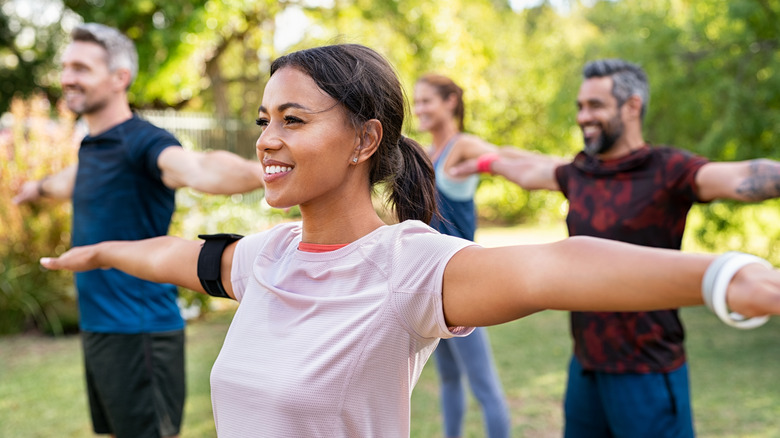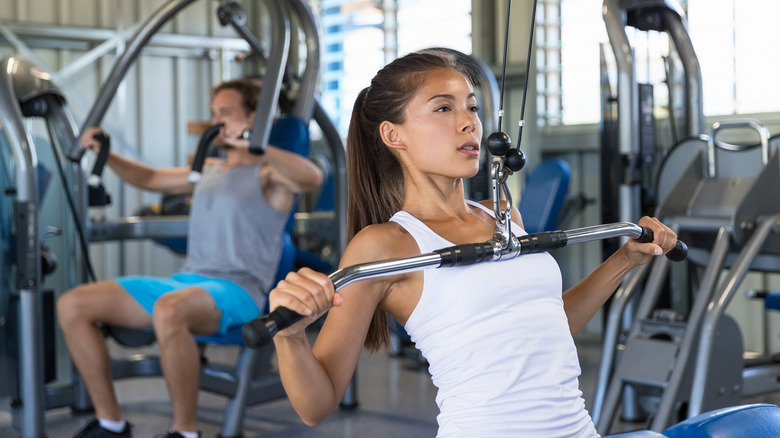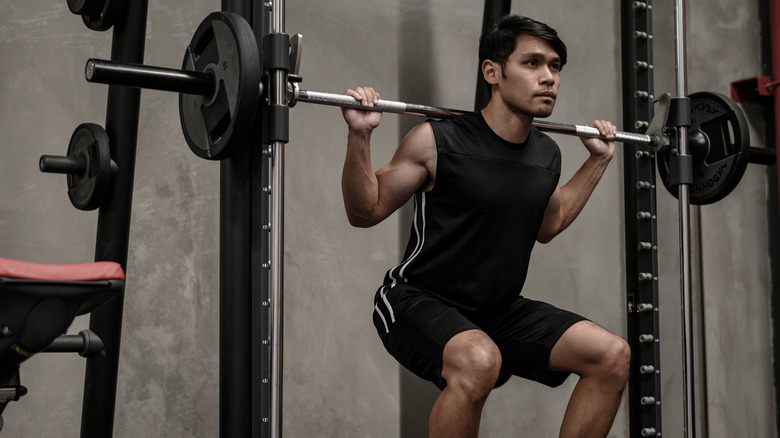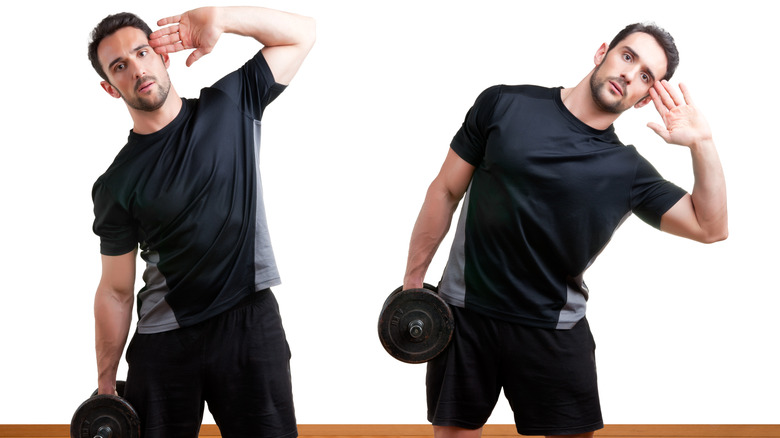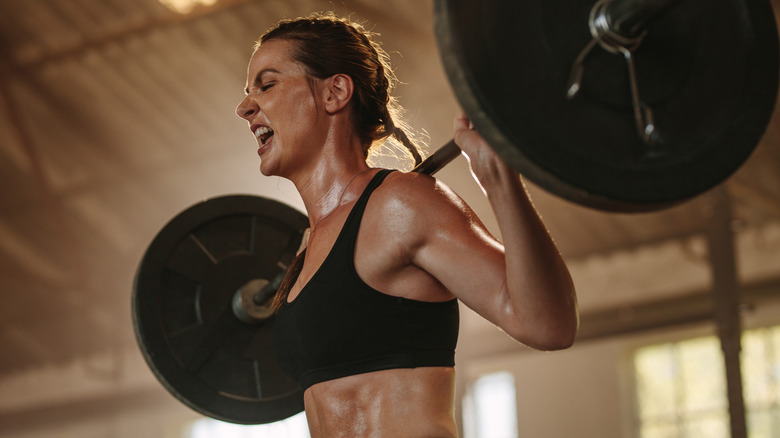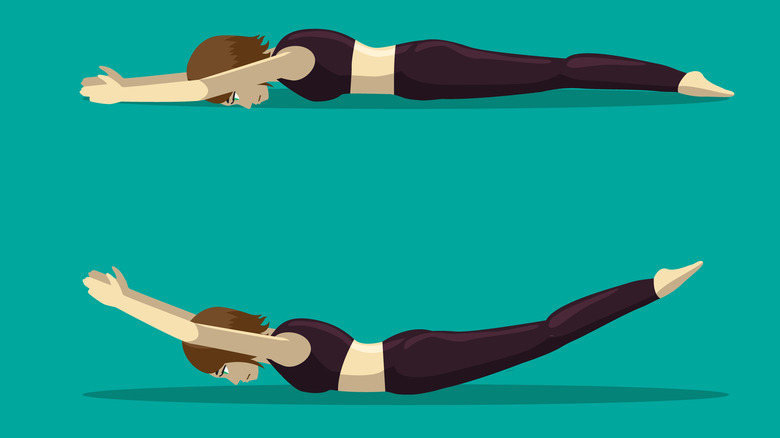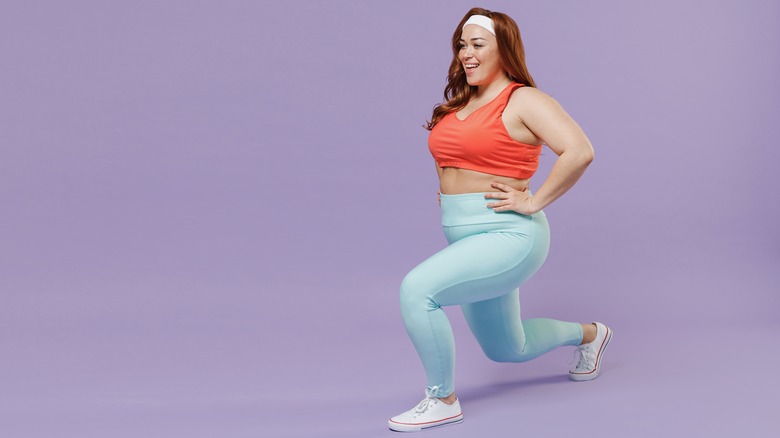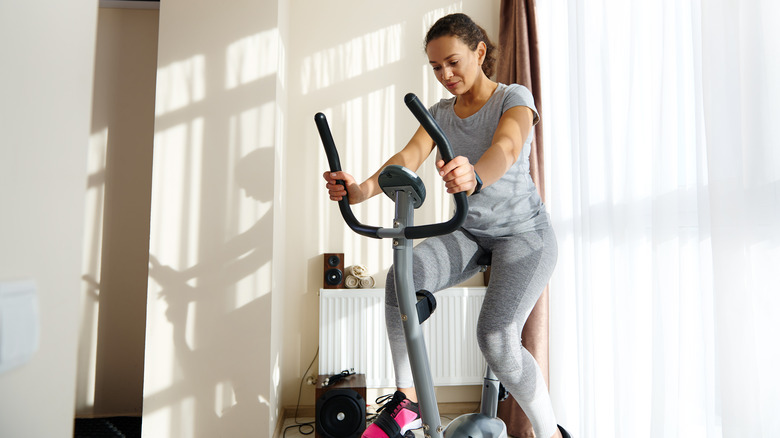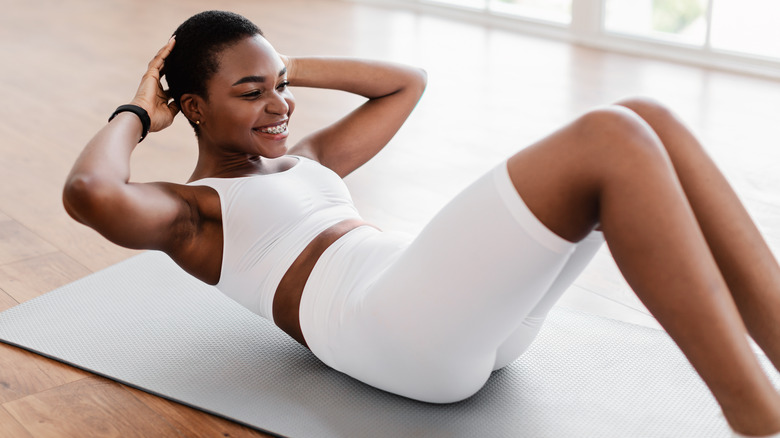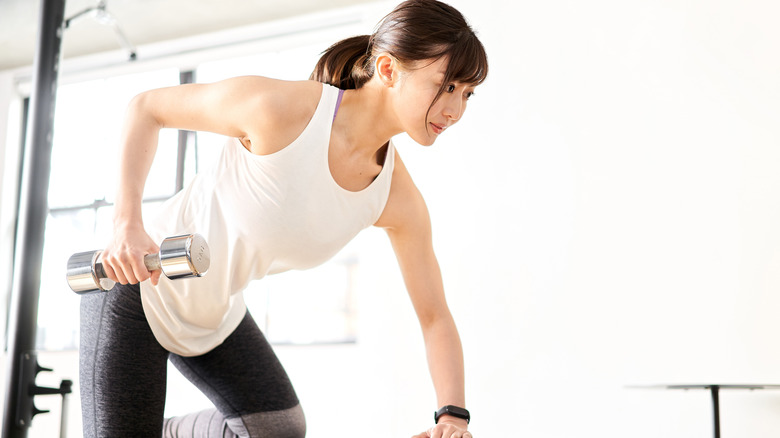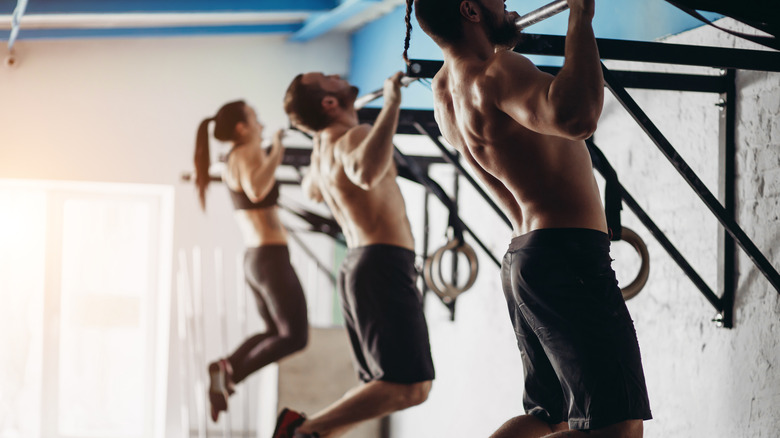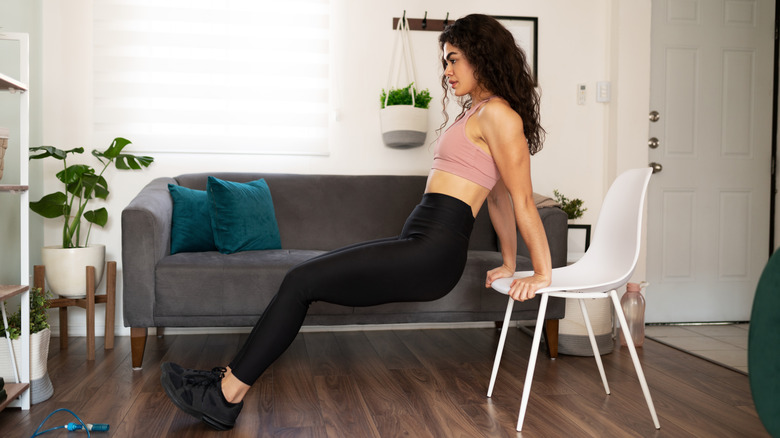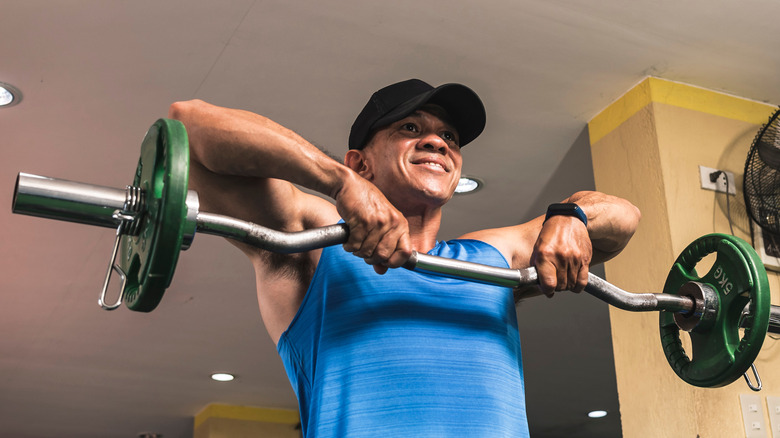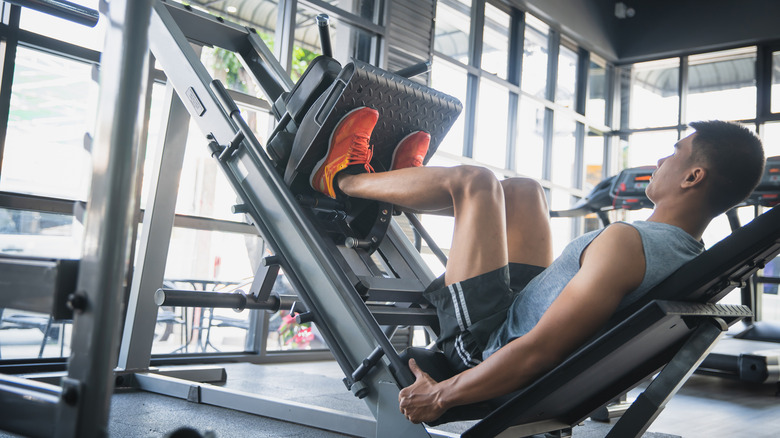Unsafe Exercises You Should Stop Doing And What To Do Instead
You've probably heard the cliché: Working out is good for you. But are there circumstances when it's not? Exercise has a wide range of both physical and mental health benefits. Regular exercise helps you maintain a healthy weight; lowers your chances of developing serious health conditions like cancers, heart disease, and diabetes; builds strong muscles and healthy bones; and supports mobility (via the Centers for Disease Control and Prevention).
Working out can also boost your mood, help reduce anxiety and depression, increase energy levels, and sharpen your memory and brain health. And it can be helpful for those struggling with chronic pain or sleep issues (per Healthline).
While the countless benefits of working out are undeniable, there are some exercises that can actually do more harm than good to the body. For most exercises, there is a right way and a wrong way to do them — and there are also alternatives.
Signs you're doing an exercise incorrectly
So how do you know if you're doing it wrong? There are a few signs to look for that indicate you may not be exercising properly. First and foremost, you should not be feeling pain. Forget what Jane Fonda said: "No pain, no gain" is not a motto that should be applied to working out. According to Dr. Robert S. Jolson, orthopedic surgeon, pain is your body's way of communicating to stop. Feeling tired or sore during exercise is common, but pain is a sign that you are performing an exercise wrong, which could result in injury over time (via American City Business Journals). Experiencing any pain during or lingering after a workout is a sign that something is off that shouldn't be ignored.
Another indication you may be exercising incorrectly is if you're not feeling the target muscles engage during the workout. For example, a twinge in your low back during a squat is a sign that you should evaluate your form. Steven Mack, certified strength and conditioning specialist, emphasizes that there's not one specific type of "perfect form," but there is a range of what's called "acceptable form" that you should aim for (via Simple Solutions Fitness). It's common to compromise form when you're pushing yourself too hard, so make sure to keep checking in with your alignment during intense workouts. Let's explore some common exercises and go over tips for how you can avoid mistakes.
Lat pull-downs
A lat pull-down is performed on the pull-down machine. The biggest common mistake here is pulling the bar behind the back of your head. This can lead to injury if your posture isn't perfectly straight, which is only possible to achieve if you have extremely flexible shoulder joints. Plus, if the bar taps the back of your neck, it's not good for your spine (via WebMD).
Instead, try this exercise by pulling the bar down in front of your face. When you sit down on the pull–down machine, grab the bar a little bit wider than shoulder-width distance, and lean back slightly. As you pull the bar down toward your breastbone, focus on pulling your shoulder blades down your back and toward each other. Engage your core muscles to fuel the movement instead of trying to use momentum to get the bar moving up and down. You should feel both your lower and upper back muscles activate with this exercise.
Smith machine squats
Alex Robles and Brittany Robles, both doctors and personal trainers, recommend avoiding the smith machine altogether (via The White Coat Trainer). According to them, it's "the worst piece of equipment any gym has." Because the bar is fixed in the same position as it moves up and down, it pushes your body into abnormal postures that can lead to back problems like a herniated disc.
The machine also encourages people to place their feet too far forward, increasing the chance of injury (per WebMD). Instead, perform a squat without a machine, either with free weights like dumbbells or using no weights at all. Be sure to keep a straight posture and your feet at shoulder-width distance. Slowly bend your knees and hinge at the hips, sending them back like you are sitting in a chair, while keeping your weight in your heels. Then gently return to standing. You should feel your glutes, hips, thighs, calves, shins, and abs engage — not the low back (via Refinery 29). Doing a proper squat can feel complicated, so if you're not sure, check with a personal trainer about your alignment.
Dumbbell side bends
A popular exercise for targeting your love handles and toning the obliques is the dumbbell side bend. It involves holding a dumbbell in one hand, doing a side bend to move the dumbbell closer to the ground, then returning back to standing (via Fitness Volt). This exercise is not only ineffective, but it's also dangerous for your spine. "Most of the time, it involves too much lateral bending and twisting of the spine," performance specialist Matt Cheng told Best Life.
A better alternative exercise is hanging oblique knee raises on a bar, according to Cheng. This movement successfully works your obliques without compromising your spine. To try it, find a pull-up bar and start by gripping the bar with your body and legs straight and your feet touching. Slowly bend your knees and bring them up toward your right armpit, then straighten your legs back to the original starting position. Then, bend your knees again, this time reaching them toward your left armpit. Continue this movement, going back and forth to each side. Try not to swing your legs to use momentum, rather use the strength of your core to lift them up.
Military press
The military press, also sometimes called an overhead press or shoulder press, is a strength training exercise that uses a barbell with weights to build muscles in your shoulders, chest, upper back, triceps, and core (via MasterClass). It's considered unsafe to lift the barbell up and down from behind your head — tight shoulders can lead to improper form and it can be risky for the back of the neck.
When practicing a military press, make sure the bar stays in front of your head (via WebMD). Also, avoid moving the bar lower than your collarbone and try to keep your posture straight. If you're concerned about tweaking your low back, try the exercise seated instead. Just be sure to use a chair with a backrest and focus on maintaining your spine's natural curve by pushing your upper back and glutes in the chair. You can also try ditching the barbell and practicing the exercise by using free weights like kettlebells or dumbbells.
Superman
The superman move, where you lay on your stomach and lift your legs and upper body up off the ground, is a popular exercise to help strengthen your low back, glutes, hamstrings, and core (via Healthline). However, it can actually put too much strain on the lower back muscles from repeated overextension, which can result in back pain.
Instead, you can try reverse back extensions, which targets most of the same muscles, without the risk of hyperextending your back. To practice a reverse back extension, begin by leaning on a stability ball with your stomach on the ball and your hands and feet touching the ground. Engage your glutes, core, legs, and back muscles, and press your legs into each other as you slowly lift them up off the ground. Keep your legs straight and only lift them up so that they are parallel to the floor — no higher — then slowly lower them back down (via Best Life).
Leg extension machine
When it comes to proper form, the leg extension machine has poor design. According to Chris Ryan, certified strength and conditioning specialist, it puts a lot of pressure on the back of the knee cap, which is unsafe because this area has only a thin layer of cartilage. "The leg extension machine applies constant tension to the anterior cruciate ligament (ACL) and increases the risk of the patella (knee cap) sliding right or left," Ryan told Best Life. Instead, he recommends focusing on deadlifts, squats, lunges, or Bulgarian split squats to strengthen your quads and glutes. Lunges are beneficial because they help strengthen your balance and coordination.
To practice a proper lunge, begin standing with your feet hip-width distance apart. Step your right foot forward and widen the distance between your legs until your right thigh, left knee, and left shin are all parallel to the ground. Avoid pushing your right knee past your right ankle. After a brief pause, return to standing and repeat on the other side.
Cardio machines
Cardio is an important physical activity to include in your workout routine, but incorrect form can lead to injury. Bad posture or squeezing too hard on the handle bars of a machine, for example, can jeopardize your body alignment and put excess strain on your spine, shoulders, and elbows (via WebMD). While it's good to challenge yourself in a workout, setting the intensity too high can tempt you to overcompensate. What you can (and should) do is increase the incline or resistance on a machine incrementally. In addition, instead of tightly holding onto the machine, make sure to use a light grip or don't hold on to the machine at all — for instance, forgoing the handlebars on a treadmill during a workout can help build your core muscles.
It's also important to switch up your cardio routine. If you use the same machine every time, you're increasing your chance for muscle imbalance and injury. Repetitive motion with improper form can lead to problems as well (via Insider). Swimming is a great cardio alternative to biking or running.
Crunches and sit-ups
Crunches are actually quite ineffective at strengthening the core, especially if you're doing them with improper form, like with your hands behind your head to help pull yourself up (via The White Coat Trainer). Most people focus on stacking quantity over quality, ignoring form to hit a number goal. Bad form is unsafe for your spine and can lead to poor posture and potential spinal injuries. Instead, focus on functional exercises – movement that directly translates to activities you perform in your everyday life – for building your core strength.
A good example is medicine ball wood chops; while you may not be chopping wood on the daily, this exercise will help build you core strength for things like lifting groceries or children (via Best Life). To practice medicine ball wood chops, start by holding a medicine ball and standing with your feet under your hips and knees slightly bent. With straight arms, pull the medicine ball up toward your right shoulder, then move it diagonally across and down toward your left knee. Gently return to your starting position and repeat on the other side. Other core engagement exercises you could try include planks or leg lifts.
Tricep kickback
A tricep kickback is when you hold a dumbbell in one hand and pull that arm back behind you while standing in a slightly crouched over position. It's very common to do this exercise with improper form and it puts unnecessary stress on both your shoulders and elbows (via The White Coat Trainer). Instead, try doing close grip push-ups, close grip bench presses, or lying tricep extensions. A close grip push-up is like a regular push-up but with your hands closer together. To perform one properly, start in a plank position with your hands under your shoulders. From there, slide your hands 1 or 2 inches closer to each other. As you slowly move in and out of the push-up, make sure to keep your elbows tucked in by your sides and touching your torso the whole way through – this step is key to targeting your triceps in this exercise (via Men's Health).
Improper pull-ups or chin-ups
Sure, practicing a pull-up looks brawny, but not if you're doing it wrong. A common mistake when practicing pull-ups is to lift your chin up to make it easier to get above the bar, which not only cheats your muscles, but it also compromises your neck and contributes to poor posture (via The White Coat Trainer). Let's break down how to properly practice a pull-up or chin-up. First of all, pull-ups and chin-ups are quite similar — the main difference is in the hands. A pull-up grip on the bar is when your palms face away from you, while a chin-up grip is with palms and fingertips facing toward you. The body action is the same. Once you choose your grip, grab a hold of the bar slightly wider than shoulder-width distance. Then, externally rotate your shoulders, activate your core and glutes, and slowly pull your chest to the bar. Keep your head in a neutral position, gazing forward, and don't look up or move your head. If you can't get your chin above the bar, simply lower back down — don't push it (via The White Coat Trainer).
Chair dips
Chair dips, often called tricep dips because those muscles are targeted in this exercise, also work the arms, pecs, and traps (via Healthline). While this exercise is popular, it is easy to do incorrectly, since it's generally considered an advanced move. If you have tight shoulders, as many people do, it can be a challenge to safely reach proper form and you can end up hurting your shoulders in the process.
To avoid injury, it's important to make sure that your hands are facing out — not toward you — with your thumbs pointing toward you and your fingers pointing out to the sides. Also, squeeze your shoulder blades together as you dip up and down to protect your shoulder joints (via The White Coat Trainer). Avoid shrugging your shoulders up toward your ears and try to keep your neck muscles relaxed. Keep your elbows straight behind you and don't let them wobble out to the side. If you want to skip chair dips altogether, you can practice close grip push-ups instead.
Upright row
An upright row involves holding a barbell or two dumbbells with straight arms out in front of you, then pulling the weight up toward your chin while keeping it close to your torso as you move. The main issue with this movement is that it requires internal rotation of your shoulder while under pressure, which jeopardizes your rotator cuff over time and increases your risk of pain or injury (via The White Coat Trainer).
Instead, you can try power cleans, the standing dumbbell overhead press, or dumbbell lateral raises. To practice a standing dumbbell overhead press, start by holding a dumbbell in each hand and bending your elbows so that the dumbbells are hovering near your shoulders. Engage your core and glutes and slowly lift the dumbbells up as you straighten your arms. Try to get your wrists, elbows, and shoulders all in one straight line. Lower back down to your starting position — this is one rep. Avoid arching your back as you move through this exercise (via The White Coat Trainer).
Leg press machine
The leg press machine is commonly used to build the quadriceps, hamstrings, and glutes. While popular, the machine puts the knees in a risky position and has the potential to cause pain (via WebMD). "The leg press machine is very bad mechanically for your body, because it does not allow your muscles/joints to perform in a functional manner and puts a tremendous amount of stress on your knees and lower back," fitness trainer Josh Stolz told Men's Journal.
Instead, opt for more functional exercises like squats, lunges, or step-ups (via Chron). If you really want to use the leg press machine, avoid bending your knees too deeply and keep your glutes firmly planted on the seat at all times. Sometimes more motion means a better workout for your joints, but in this case, if you experience any pain in your knees or low back, back off and don't push it (per WebMD).

